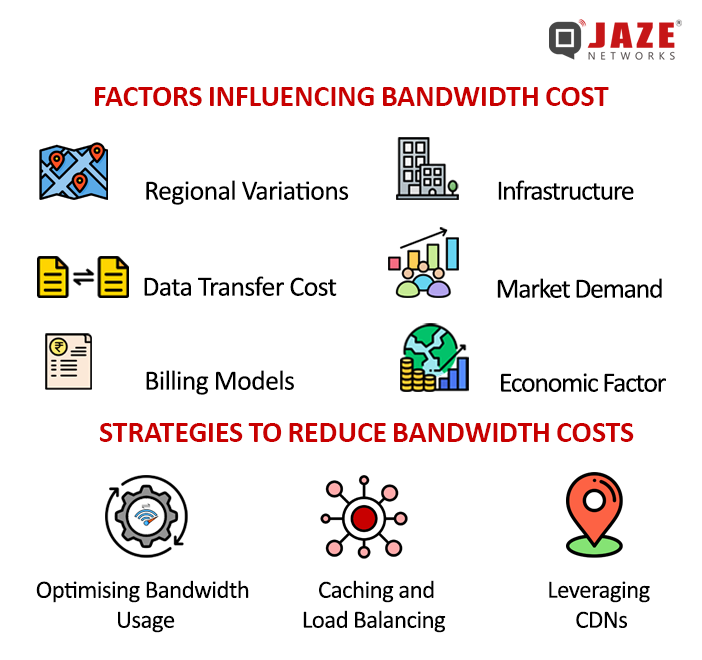As digital consumption continues to rise, bandwidth management has become crucial for businesses, especially those reliant on cloud services. Bandwidth, the amount of data transferred over a network in a given time, plays a significant role in determining operational costs. Without effective control, bandwidth expenses can escalate quickly, particularly in industries dependent on high volumes of data transfer.
This article will explore the key factors influencing bandwidth costs and provide strategies to reduce them.

Factors Influencing Bandwidth Costs
Understanding what drives bandwidth expenses helps businesses manage their usage efficiently and avoid unnecessary costs. Here are some critical factors that affect bandwidth pricing:
1. Regional Variations
Bandwidth costs can differ based on geographic regions. Areas with advanced infrastructure and competitive markets tend to have lower costs. Conversely, regions with underdeveloped infrastructure or monopolistic market conditions face higher prices.
2. Data Transfer Costs
Many providers charge based on the volume of data transferred, typically measured in gigabytes (GB). Outbound data (sent from your network) often incurs higher costs compared to inbound data (received by your network). Providers like Google Cloud or AWS follow this model, where inbound transfers may be free, but outbound data can significantly drive up costs.
3. Billing Models
Different billing models can influence how much you pay for bandwidth:
Flat-Rate Pricing: A fixed monthly fee ensures cost predictability but may result in paying for unused bandwidth.
Pay-As-You-Go: Costs are based on actual usage, which is flexible but can lead to high expenses during peak periods.
Tiered Pricing: A tier-based approach offers a balance of predictability and flexibility, accommodating business growth.
4. Infrastructure and Peering
Regions with well-developed peering exchanges enable more efficient data transfer between networks. This reduces bandwidth costs by lowering the need for long-distance data transmission.
5. Economic Factors
Bandwidth costs are also affected by external factors such as power, cooling, and real estate costs. Data centers located in regions with high electricity prices or expensive real estate tend to pass those costs onto their customers.
6. Market Demand
In areas of high internet demand, especially during peak times, service providers may increase prices. High market demand for bandwidth can drive up prices, particularly in growing internet markets.
Strategies to Reduce Bandwidth Costs
To manage bandwidth expenses effectively, businesses must adopt strategies that optimize their data usage. Here are some key ways to reduce bandwidth costs:
1. Optimizing Bandwidth Usage
Managing bandwidth usage is essential for minimizing unnecessary data transfer:
Data Management: Prioritize essential data transfers and schedule non-essential ones during off-peak hours to reduce congestion.
Compression Techniques: Compressing large files such as images or videos before transferring them can drastically reduce the amount of data sent, lowering bandwidth costs.
Monitor Usage: Regularly analyzing bandwidth usage can reveal inefficiencies or heavy usage patterns, guiding businesses to implement specific cost-saving measures.
2. Caching and Load Balancing
Caching allows frequently accessed data to be stored locally, reducing repeated data transfers. For instance, implementing caching for images or videos can drastically cut data transfer to and from the server. Load balancing helps distribute network traffic across multiple servers, reducing the strain on any single server and preventing bandwidth overuse.
3. Using Content Delivery Networks (CDNs)
A CDN consists of a network of servers distributed across multiple locations, which cache and deliver content closer to users. CDNs reduce the load on the original server by handling static content like images, CSS files, and videos. This minimizes the need for repeated data transfer from the origin server, leading to significant bandwidth savings. CDNs are highly effective, often managing 60-80% of a website’s bandwidth, allowing the original server to focus on more critical functions.
Monitoring bandwidth usage regularly will also help businesses avoid unexpected costs and ensure more efficient network management. Implementing these methods can provide both immediate savings and long-term benefits, making them crucial for growing companies in today’s digital landscape.
Jaze ISP Manager provides comprehensive tools for monitoring bandwidth usage, offering real-time insights and detailed usage reports. This solution enables Internet Service Providers (ISPs) to manage end-to-end operations, including subscriber lifecycle management, billing, and policy enforcement. With features like automated provisioning, flexible billing options, and integration with various network equipment, Jaze ISP Manager helps businesses optimize resource allocation and ensure efficient network performance. Click here to learn more






